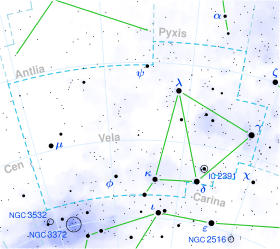| Observation data Epoch J2000.0 Equinox J2000.0 | |
|---|---|
| Constellation | Vela [1] |
| Right ascension | 10h 08m 56.2396s [2] |
| Declination | −51° 48′ 40.542″ [2] |
| Apparent magnitude (V) | 4.85 [1] |
| Characteristics | |
| Spectral type | B3III/IV [3] |
| B−V color index | −0.120±0.004 [1] |
| Astrometry | |
| Radial velocity (Rv) | +14.0±4.2 [1] km/s |
| Proper motion (μ) | RA: −15.556±0.103 [2] mas/yr Dec.: +0.667±0.102 [2] mas/yr |
| Parallax (π) | 2.0767±0.1021 mas [2] |
| Distance | 1,570 ± 80 ly (480 ± 20 pc) |
| Absolute magnitude (MV) | −3.19 [1] |
| Details | |
| Mass | 9.1±0.2 [4] M☉ |
| Radius | 4.5 [5] R☉ |
| Luminosity (bolometric) | 9,580 [6] L☉ |
| Temperature | 17,900 [6] K |
| Age | 23.8±2.3 [4] Myr |
| Other designations | |
| Q Velorum, 186 G. Vel, CD−51°4507, HD 88206, HIP 49712, HR 3990, SAO 237736 [7] | |
| Database references | |
| SIMBAD | data |
HD 88206 is a star in the southern constellation of Vela. HD 88206 is its designation in the Henry Draper catalogue and it also has the Gould designation 186 G. Velorum and the Bayer designation Q Velorum. The star has a blue-white hue and is faintly visible to the naked eye with an apparent visual magnitude of 4.85. [1]
Parallax measurements provide a distance estimate of approximately 1,570 light years from the Sun. It is drifting further away with a radial velocity of +14 km/s. [1] Although a young star and positioned in the general vicinity of the Scorpius–Centaurus association, it is most likely not a member. [8]
This massive star has a stellar classification of B3III/IV, [3] which suggests it is entering the giant stage of its evolution. It is 24 [4] million years old with 9 [4] times the mass of the Sun and about 4.5 [5] times the Sun's radius. The star is radiating 9,580 [6] times the luminosity of the Sun from its photosphere at an effective temperature of about 17,900 K. [6]
